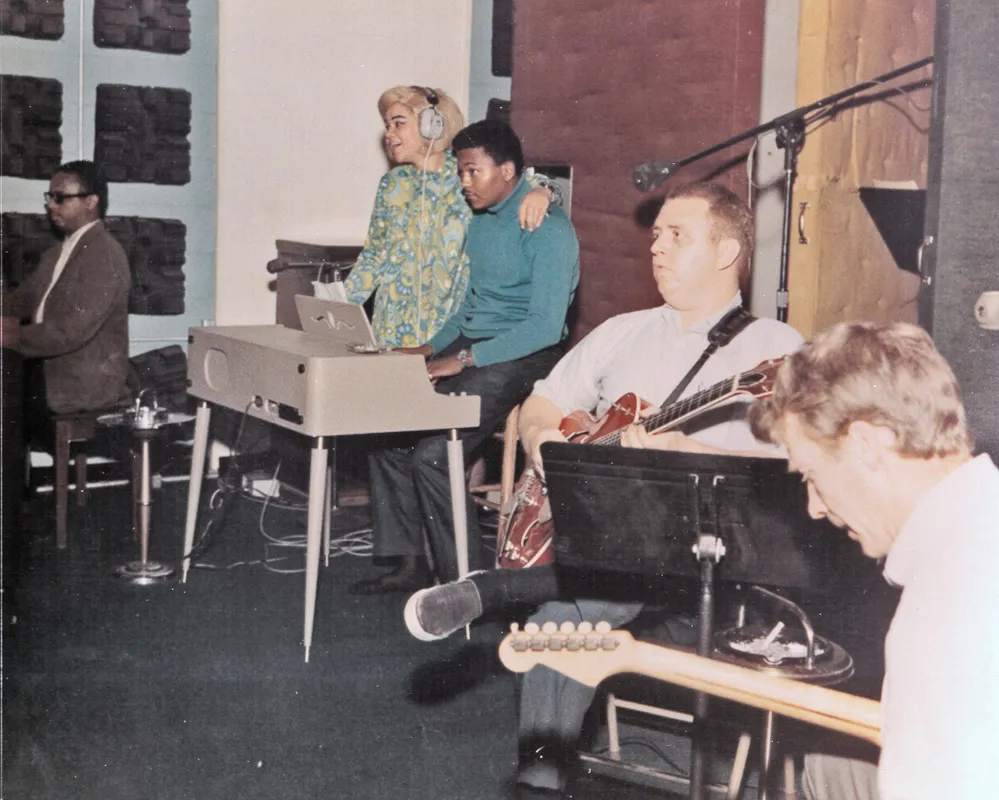It happened a fair few times in the ’60s and ’70s that a top star would come down to Muscle Shoals, Alabama looking to tap into whatever mysterious forces were spawning classics like Percy Sledge’s “When a Man Loves a Woman” and Jimmy Hughes’ “Steal Away.” For whatever reason, that little corner of the world was pumping out world-class hits—seemingly out of nowhere.
Videos by American Songwriter
The studio behind the magic was Rick Hall’s whole in the wall, FAME Studios. The unglamorous and unfettered establishment was home to a top-notch gang of session musicians, The Swampers (of Lynyrd Skynyrd fame), that put an unmistakable flare on everything they touched. The Swampers and Hall’s sharp production paired with the virtually distraction-free area went on to strike gold a number of times throughout the ’60s.

After a disagreement spawned a Swampers-helmed offshoot, called Muscle Shoals Sound Studio, the two studios shared in the great wealth of talent coming to the area, both becoming the backdrop for far too many great songs to focus on just one. Below, we’re going through 10 of the best songs recorded at FAME Studios and Muscle Shoals Sound.
1. “Mustang Sally”—Wilson Pickett
Though this R&B classic was originally recorded by Mack Rice in 1965, it saw greater popularity when Wilson Pickett covered it the following year.
Once FAME studios caught the attention of Jerry Wexler at Atlantic Records, he sent Pickett there to record “Mustang Sally” along with another one of his classic hits, “Land Of 1,000 Dances.” Pickett’s session of “Mustang Sally” nearly ended up on the cutting room floor —literally. After Pickett finished his final take, the tape flew off the reel and broke into pieces. The session engineer, Tom Dowd, then cleared the room and painstakingly pieced the tape back together, saving what would become one of the biggest soul hits of the ’60s.
2. “When a Man Loves a Woman” – Percy Sledge
Quite green to the recording process, Percy Sledge was a hospital orderly by trade when he stepped in front of the microphone to record “When a Man Loves a Woman” at Muscle Shoals Sound.
“At that time Percy had never sung on a record before,” says Jimmy Johnson, who recorded the session. “And the performance he gave was so pristine and so good that it was almost hard to believe that was his first time. I think he was pretty scared to death when he came there that day but it gets pretty lonely when you’re looking at some people in the control room as you’ve got a mic in front of you. But I tell you what, that vocal on there…”
3. “I’ll Take You There” – The Staple Singers
Producer Al Bell signed The Staple Singers to Stax Records in 1968. At that point, The Staples had moved away from protest songs and toward what they called “message music.” The first two albums under the Stax deal, Soul Folk in Action and We’ll Get Over, saw a lackluster response.
Bell decided to take The Staples to Alabama and let them record with the Muscle Shoals Rhythm Section, aka The Swampers. It was during these sessions that the group found the sound that would make them stars and in August 1971, they recorded their hit “I’ll Take You There.”
4. “I’d Rather Go Blind” – Etta James
Etta James recorded both “Tell Mama” and “I’d Rather Go Blind” at FAME studios. Her sessions came at a time that the powerhouse vocalist was trying to curb heroin addiction. The move to the Muscle Shoals studio both kept her away from the temptations of life in the city and provided new musical inspiration.

One of the Swampers, David Hood, recalls James nailing “I’d Rather Go Blind” in a single take saying, “It was a pretty simple song, but her performance was great and apparently our performances were good too.”
“I’d Rather Go Blind” and “Tell Mama” have gone on to be one of the most acclaimed double-sided single releases of the period and enduring hits.
5. “Old Time Rock and Roll” – Bob Seger
Bob Seger recorded many of his iconic tracks with the Swampers backing him up. The session musicians sent Seger a demo of what would become “Old Time Rock and Roll” amid the recording sessions for his 1984 album Stranger in Town.
While the song was recorded, in part, back home in Detroit, it has that unmistakable Swampers rhythm section from the time spent at Muscle Shoals Sound, which ups the groove ante tenfold.
6. “Preacher’s Daughter
As any Lynyrd Skynyrd fan knows, their first album, Pronounced ‘Lĕh-‘nérd ‘Skin-‘nérd, was released in 1973. However, die-hards will know that an entirely different album was set to be their debut—an album full of songs recorded in Muscle Shoals.
The early demos were recorded between 1971 and ’72 and were ultimately scrapped in favor of what would become Pronounced. For years, fans knew nothing of the recordings until a plane crash claimed the lives of lead singer Ronnie Van Zant and guitarist Steve Gaines. After the tragic accident, the surviving members released the Muscle Shoals recordings in their entirety on Skynyrd’s First and…Last.
One such song was the wailing “Preacher’s Daughter,” which highlights all the best of the original Skynyrd lineup. Not to mention they enjoyed their time in Muscle Shoals so much that they felt inclined to defend the state in what is arguably one of the biggest anthems of all time, “Sweet Home Alabama” – Now Muscle Shoals has got the Swampers / And they’ve been known to pick a song or two
7. “The First Cut Is the Deepest” – Rod Stewart
Rod Stewart recorded his version of Cat Stevens’ classic “The First Cut Is the Deepest” at Muscle Shoals Sound Studio.
Released as a double A-side single with “I Don’t Want to Talk About It,” the cover became a hit on both sides of the Atlantic. As with many other artists that visited the two Muscle Shoals studios, the sessions were transformative for Stewart’s sound in the mid-’60s
8. “Kodachrome” – Paul Simon
According to the Swampers, Paul Simon wanted to come to the Muscle Shoals Sound studio to record one song—”Take Me To The Mardi Gras”— after hearing “I’ll Take You There” by The Staple Singers. After nailing the song in one take, Simon and the Swampers were stuck figuring out what to do with the subsequent four days he had blocked out.
Simon eventually sat in the middle of the floor and began playing riffs on the guitar. “If you hear something you want to record, let me know, he said. Together they ended up picking out the honky-tonk-flavored “Kodachrome” along with over two-thirds of what would become his 1973 album, There Goes Rhymin’ Simon.
9. “Wild Horses” – The Rolling Stones
The Rolling Stones took the trip down to Muscle Shoals for a three-day recording session that would result in three of Sticky Fingers’ most iconic tracks. Channeling the swampy music of the area, the Stones wrote and recorded “Brown Sugar,” “You Gotta Move” and the track we’ve chosen for this list, “Wild Horses.”
“Muscle Shoals Studio was in this rather interesting place. Being there does inspire you to do it slightly differently,” Jagger once said, crediting the studio for Sticky Fingers‘ now-iconic sound. Departing from their usual blues-tinged material, on “Wild Horses” the Stones took a hard left into classic country music. With a simple acoustic riff in “Nashville tuning,” it seems the trip down south was worth it as it’s hard to imagine this song would have come from the Stones any other way.
10. “I Never Loved a Man (The Way I Love You)” – Aretha Franklin
It’s hard to imagine a time when Aretha Franklin wasn’t clinching chart-topper after chart-topper. But that was indeed the reality before she visited FAME studios in 1967. Past producers had the Queen of Soul singing jazzy, pop hits that dulled her shine. Hall and the Swampers let her voice run free, resulting in Aretha finally finding the sound that would take her all the way to the top.
One song that resulted from the FAME sessions was “I Never Loved A Man (The Way I Love You).” Despite a disagreement between Hall and Franklin’s then-husband, Ted White, ending the sessions early, the slow-burning number became the title track of her breakthrough album and gave the world its first taste of what was to come with Franklin – heart-pounding, core-shaking soul.
Photo: Atlantic Records
